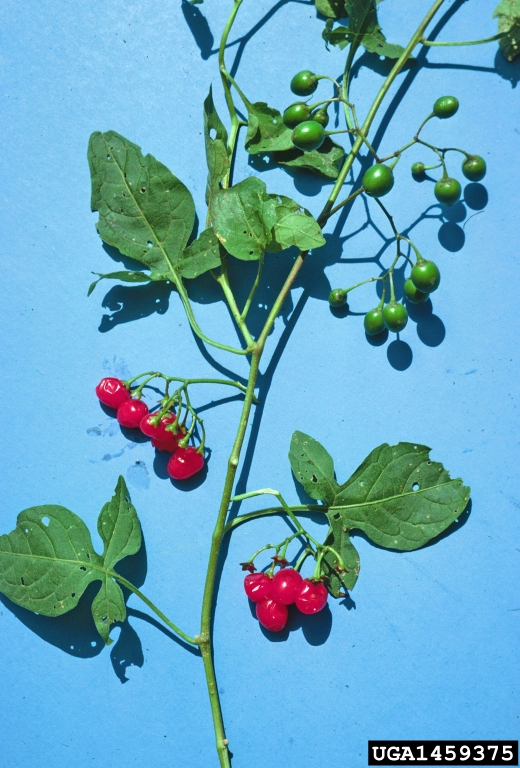Bittersweet Nightshade Bugwood
 | Author:
Allison Kosto, MSU Broadwater County Extension Agent
MSU Broadwater County Extension Agent |
Bittersweet Nightshade Bugwood Allison Kosto, MSU Broadwater County Extension Agent Although not as poisonous as the famed deadly nightshade, all plant parts of bittersweet nightshade, sometimes called climbing nightshade, are still poisonous. It is very common in Broadwater County and even though it is not a noxious weed, it is still an important plant to be able to identify.
Description & Habitat Native to Eurasia, Bittersweet Nightshade was introduced to North America as an ornamental plant. It has naturalized to temperate climates across the world. Although toxic, its roots, historically, had a variety of uses from witchcraft to treating bruises. It tends to prefer moist areas and is found along creeks, wetlands, field edges, gardens, yards and roadsides. It is a vine so can often be seen climbing bushes, fences and other structures. It can also look like a shrub if it does not have anything to climb.
Bittersweet Nightshade is a perennial (life cycle of more than two years). The plant has lance or heart-shaped leaves; they are dark green, sometimes with a purple tinge. Stems, especially at the base of the plant, can be woody. It produces shooting star-like flowers that are purple with a yellow cone-like center. After flowering, bittersweet nightshade produces a cluster of pea-size berries. They change from green to orange to red as they mature. All stages of maturity can be found on the same plant, sometimes even the same berry cluster. The plant also has a strong unpleasant order. It spreads by seeds as well as stem and root fragments. Birds are often responsible for dispersing seeds.
All parts of the plant are toxic. The main concern is that children may mistake the berries for an edible berry. There have been documented poisonings in dogs, cattle and sheep. However, this is very rare. Most animals avoid the plant because of the strong odor.
Management Fortunately, Bittersweet Nightshade does not tend to take over larger areas. It can form small dense colonies in certain situations or have dispersed plants. This means that if control measures are necessary, it is often in a smaller area like a yard where there is a risk of children finding the berries.
Digging or pulling can be effective when the plants are young, and the soil is moist... The entire root system must be removed to prevent regrowth. Mowing is not always effective and must be done repeatedly throughout the growing season.
Herbicides can be effective, especially in larger infestations, or in combination with other control methods. Commonly used herbicides include Curtail, Garlon, Polaris, Roundup, Stinger and Transline. Always read and follow the entire label when applying herbicide. Common chemical names are used for clarity but does not imply endorsement of a product or brand.
For assistance on weed identification and management, contact the MSU Extension Office in Broadwater County at 406-266-9242.
Article Images
Click on Image Thumbnail(s) to view fullsize image
PhotoCredit: Allison Kosto
Image 1 Caption: a Bittersweet Nightshade
